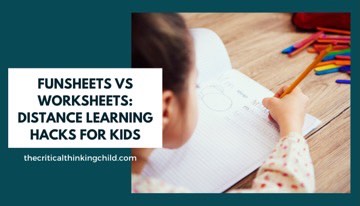What’s in a name? When it comes to schoolwork, the way you refer to activities makes a huge difference. During distance learning for kids, parents and children are receiving too many WORKsheets as part of their homeschool curriculum. This causes stress, boredom, and pushback from students who are tired of them.
That’s why, at The Critical Thinking Child, we encourage teachers and parents to ditch the traditional worksheet and instead implement FUNsheets to improve the quality of education from home. Our students love to play with our FUNsheets, but hate trudging through endless WORKsheets
The Importance Of a Name
Worksheets have been called worksheets forever, right? Why rock the boat? Think back to your own time as a student. Few, if any of us, got excited when the teacher passed out a worksheet or assigned a worksheet for homework. It gives a mental image of boredom, rote learning, and pages and pages of the same type of problem.
It may sound simple, but just changing the name goes a long way. The term funsheets makes us think of adventures, stories, and puzzles that engage and excite us. Kids feel the same way; if you introduce pages as FUNsheets vs WORKsheets, their level of motivation will naturally be higher. It’s a simple mental tweak that makes a big difference in your homeschool curriculum.
What Makes a Good FUNsheet?
It’s not all in the name. While using the word “funsheet” can make a big difference, the content matters as well. Again, think back to your school days and picture your most boring worksheet. Was it visually dull, with lines and lines of the same type of question? Did it promote rote learning and recitation, without any creativity or play?
If so, your experience was pretty typical. When you’re looking for sheets or designing your own, keep the following in mind:
FUNsheets Hold Visual Interest
Your funsheet doesn’t need to be filled with polka dots and rainbows, but the appearance of your sheet does matter. Look for neat organization, readable but fun fonts, and maybe some pictures or graphic organizers to offer some variety.
Speaking of graphic organizers, funsheets that are designed for interaction with go a long way towards maintaining student interest. Look for sheets that encourage cutting, pasting, folding, drawing, and other methods of learning that go beyond simply answering questions.
FUNsheets encourage critical thinking
One of the most boring parts of worksheets is that they’re usually based on memorization or rote facts rather than forcing students to think critically. To encourage critical thinking, look for sheets with open ended questions or analogies that promote problem-solving and critical thinking.
Relevant questions stimulate children’s brains much more than endless facts and figures, and they have the benefit of often applying to the real world.
FUNsheets meet students where they are
Another issue with traditional worksheets is that they’re either too easy or too difficult. If your child has already mastered a concept, a typical worksheet may lead to a regurgitation of their knowledge and take the motivation out of education from home. If, on the other hand, your child is struggling with a concept, worksheets don’t do much to help them build that foundational knowledge.
Consider looking for sheets with challenge problems at the bottom; students tend to enjoy stretching their minds with new and difficult problems. In addition, look for sheets that incorporate a variety of difficulty levels, and encourage an exploration of possible solutions, instead of simply “finding the right answer”.
Embrace FUNsheets In Your Home Classroom
As you and your children move through these new times of distance learning for kids and a new homeschooling curriculum, you can make life easier by implementing funsheets into your day.
Need a starting point? Our store has a ton of exciting sheets available, for a variety of subject areas and skills. Get started with funsheets and watch your child’s motivation grow!



